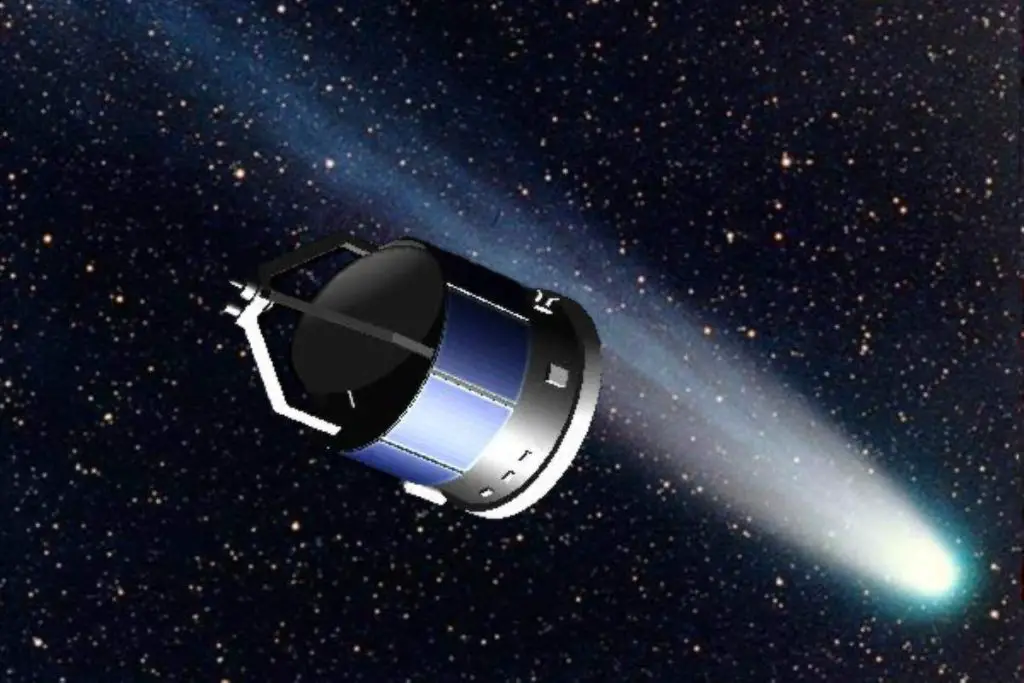On July 2, 1990, European Space Agency’s (ESA) Giotto spacecraft performed the first-ever earth gravity-assisted maneuver to be retargeted for its destination, Comet P/Grigg-Skjellerup.
Today’s (July 2) story of what happened this day in Science, Technology, Astronomy, and Space Exploration history.
Giotto spacecraft
Giotto was a European robotic spacecraft mission from the European Space Agency. It was launched on July 2, 1985.
The spacecraft was named after the Early Italian Renaissance painter Giotto di Bondone (known mononymously as Giotto, c. 1267 – January 8, 1337), who had observed Halley’s Comet in 1301 and was inspired to depict it as the Star of Bethlehem (the Christmas Star) in his painting Adoration of the Magi in the Scrovegni Chapel.
The Giotto mission was designed to study Comet P/Halley (Halley’s Comet). The major objectives of the mission were:
- Obtaining color photographs of the nucleus of the comet
- Determining the elemental and isotopic composition of volatile components in the cometary coma, particularly parent molecules
- Characterizing the physical and chemical processes that occur in the cometary atmosphere and ionosphere
- Determining the elemental and isotopic composition of dust particles
- Measuring the total gas-production rate and dust flux and size/mass distribution and deriving the dust-to-gas ratio
- Investigating the macroscopic systems of plasma flows resulting from the cometary-solar wind interaction.

The mission was successful: Giotto made its closest approach to Halley’s Comet at a distance of 596 kilometers (370 miles) on March 13, 1986. It imaged Halley’s nucleus (see notes 1) and also found the first evidence of organic material on a comet.
The spacecraft even surprisingly survived despite being hit by some small particles. One impact sent it spinning off its stabilized spin axis so that its antenna no longer always pointed at the Earth, and its dust shield no longer protected its instruments. After 32 minutes Giotto re-stabilized itself and continued gathering science data.
After the Halley encounter, its science instruments were turned off on March 15, 1986, at 02:00 UTC.
The first Earth flyby in the history of space exploration
Giotto was reactivated in February 1990 and performed the first-ever earth gravity-assisted maneuver on July 2, 1990, to be retargeted for Comet P/Grigg-Skjellerup, its extended-mission destination. This swing-by is of unique scientific interest due to Giotto’s hyperbolic, high-inclination orbit.
This was also the first encounter of Earth by a spacecraft coming from deep space. During the encounter, observations were made of the Earth’s magnetic field and energetic particles.
Giotto obtained a gravitational assist from this flyby and successfully encountered Comet P/Grigg-Skjellerup on July 10, 1992. The closest approach was 200 km (124 miles) at a relative velocity of 13.99 kilometers per second (31,295 mph or 50,364 km/h).
On 23 July 1992 Giotto operations were officially terminated after the completion of final orbit adjustments and configuration of the spacecraft for its third hibernation. Only 1 to 7 kg of fuel is left on board, insufficient for any extensive future maneuvers. Giotto flew by the Earth on 1 July 1999 at the closest approach of about 219,000 km (136,080 miles) at approximately 02:40 UT (10:40 p.m. EDT, 30 June). The spacecraft was moving at about 3.5 kilometers per second (7,829 mph or 12,600 km/h) relative to Earth. The spacecraft was not reactivated.
Giotto’s achievements
- The spacecraft made the closest approach to Halley’s Comet and provided the best data for this comet.
- It was the first spacecraft to provide detailed pictures of a cometary nucleus.
- It was the first spacecraft to make a close flyby of two comets. Young and active comet Halley could be compared to old comet 26P/Grigg-Skjellerup.
- It was the first spacecraft to return from interplanetary space and perform an Earth swing-by.
- It was the first spacecraft to be re-activated from hibernation mode.
- It was the first spacecraft to use Earth for a gravity assist.
Sources
- Giotto spacecraft on Wikipedia
- Giotto mission page on the NASA Solar System Exploration website
- “Giotto’s mission to planet earth” on the NASA Technical Reports Server website
- Space Shuttle Endeavour’s Touchdown Meets Columbia’s Salute [An amazing photo from the past] - February 29, 2024
- Moon Landings: All-Time List [1966-2024] - February 23, 2024
- From Orbit to Ordinary: 10 Earthly Applications of Space Technology - January 23, 2024

